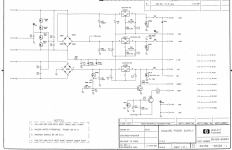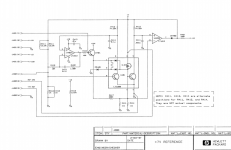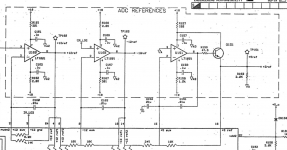Mine is discrete and at c. 15 ppm THD - not that it makes it any better of course 🙂
Salute! I didn't know it is possible.
Rubbish, you just have problems with straightforward questions and answers, that's obvious from your responses to people.
Don't blame Jakob on your failure to comprehend what's posted which you have demonstrated again & again - I told you to slow down not so long ago but it didn't help your comprehension
You’re free to do what you think is best. Just let us not pretend this is actual truth or anything but your own opinion and subjective thoughts.
Did you actually read my post and understand everything I went into before
dismissing it?
T
With 15 years in industrial measurement and instrumentation, I can assure you that only portability requires batteries.
No-one wants a DMM with a power lead.
But consider that the (probably) best bench meter available, Keysight 3458A, is mains powered.
I'm not saying reference quality power can't be achieved other than batteries/supercaps - just that standard voltage regulators used as per datasheet haven't delivered the sonic quality. if people can show the voltage regulators used in the LIGO reference circuits or the Keysight meter then I would have learned something new
Just buy some Liquid Helium, and start your experiments ?And I have the temerity to I think I'm a hero because I can build a 1nV/rt Hz amplifier . . .
Did you actually read my post and understand everything I went into before
dismissing it?
T
I did re-reply, scroll up a few.
Because I don't attach any more significance to Markw4's posts than anyone listening reports & tweaks from anyone else. Is that so difficult to understand? What is the crime you imagine I have committed? I thought we settled all this - all reports are just a bit of fun - you seem to be still struggling with the desire to have some observations posted carry more weight than others & can't seem to be equitable in this?Quite so, when MM says markw4's DAC observations should stand unchallenged I asked why they don't need to pass any kind of protocol and get nothing in response except more studies to read.
.....
I think that stability is a big thing when it comes to digital playback. Has been thinking that for ten years.
Thanks Joe
How long have you stopped taking your medication?Everybody, including casual readers, can see Jakob2's position, he placed himself in the same team with MM, T, SV, M4, MB, MH, JC, Z, ToS, JoG, JR, etc... I agree, his stances are of the most toxic kind, since it wraps the BS in a thick crust of theoretical knowledge, but I think ignoring is still the best tactic.
Those who want to believe in the FUD spread around will do it anyway, nothing will change that.
Because I don't attach any more significance to Markw4's posts than anyone listening reports & tweaks from anyone else. Is that so difficult to understand?
You could have fooled me.
I'm not saying reference quality power can't be achieved other than batteries/supercaps - just that standard voltage regulators used as per datasheet haven't delivered the sonic quality. if people can show the voltage regulators used in the LIGO reference circuits or the Keysight meter then I would have learned something new
I'm not sure where to get details on the 9 digit laser supply (9 digits really? how do you verify that?) but here are some circuits from the HP3458 DVM, supposedly the most linear 8.5 digit meter.
You can download the schematics here: Service Manual - Hewlett Packard 3458A - Digital multimeter -- Download free service manuals lots to study.
The main regulators are LM317/337. The 7V reference uses an LTZ1000 which are really nice if you need stability but a real challenge to implement. The ADC references are opamp based.
This is an old design, 1987, using reasonable tech and methods. Things have not moved much since then and no magic foo, supercaps etc. to make the instrument you would use to measure Allen variance of a DC supply.
Attachments
You could have fooled me.
It's your inability to treat all listening impressions with equanimity that you are struggling with & your internal strife is evident. Your projection is obvious
I'm not sure where to get details on the 9 digit laser supply (9 digits really? how do you verify that?)
From the final results.
It's your inability to treat all listening impressions with equanimity that you are struggling with & your internal strife is evident. Your projection is obvious
You are not listening, obviously, I treat Romy the Cat and Arthur Salvatore with total equanimity as I just said earlier today it's all personal preference. Neither of these folks have any interest in the Benchmark or digital particularly I have no problem with that at all. You forgot also that "I don't care".
BTW why not treat syn08's and PMA's comments with equanimity.
Demian,
The 18 volt supply is interesting, how does it get the start up current?
Actually may use a modification of it on my current project!
ES
The 18 volt supply is interesting, how does it get the start up current?
Actually may use a modification of it on my current project!
ES
On 2nd though, your post required a more thoughtful response than my previous reply.
OK, disregard my last post. 🙂
It is a clever use of the transport to send 8x oversampled data, if that's what you are doing.
I'm not sure what you mean by transport... this is a PC to DAC connection via asynchronous USB. I guess the PC is the 'transport'.
PCM1704 can play 768kHz, (8 x 96kHz). USB bridge can output 768kHz in B 2's compliment so can feed the 1704 directly. Very simple.
That's how I would prototype / test a filter before implementing it in an FPGA. Still, you're limited to 96 kHz if you do an 8x OSF.
HQplayer does the filtering and upsampling. This is the whole point.
I am not a fan of NON-OS, so I wouldn't be doing that. Not sure how you can get DSD into a PCM1704 though... no big loss for me, though.
WRT DSD, you would have to do format conversion in HQplayer (or other playback software platforms). I would rather play native DSD into the DAC and I feel DSD256 is *possibly the best sounding format so the MB DAC is not something I'm going to do. The DAC discussed came through for repair / upgrades.
I agree that running fully synchronous with the source is best and not really a fan of the ASRC-everything approach.
Exactly.
Still, I don't think John is the type to be tinkering with HQPlayer. I also don't think it would address any of his issues, because I suspect the issues are perceived instead of real.
WRT HQplayer, not sure, JC? ... possibly Mark4 can help. WRT perceived vs real, I doubt it.
First time I heard a good mix from 16T 2" Ampex machine, through HQ console into speakers I was absolutely knocked out with the quality of sound
I think this is the sort of thing JC is looking for, but has so far not found.
Too much talk, work to do. 🙂
T
Thanks, Markw4! Several seconds is a lot, but that applies to those fancy players, right? I don't need DSD, just regular PCM, 192k max. I'm on a Mac, so I won't be using ASIO and won't be recording, just editing. (I'm using DAW called Soundblade).Using the system Terry suggests, latency primarily comes from DSP if using HDplayer and or Roon on the computation engine i7 box. It can be a few or several seconds delay for highest quality DSD playback of PCM source material even with a very fast computer.
The JLsounds I2SoverUSB board itself is fast enough for DAW use, but if using its ASIO driver then your DAW might not be able to access any other ASIO devices at the same time, such as for recording inputs if needed.
On a related note, as a reality check. A couple of videos on how the stuff you (we) are listening is REALLY made 😀
YouTube
YouTube
YouTube
See the wood blocks to keep cables off the floor at 6:28:
YouTube
Now forum resident trolls can start ridiculing the studio owner. But check his bio before doing that! 😉
Best,
Thanks DemianI'm not sure where to get details on the 9 digit laser supply (9 digits really? how do you verify that?) but here are some circuits from the HP3458 DVM, supposedly the most linear 8.5 digit meter.
You can download the schematics here: Service Manual - Hewlett Packard 3458A - Digital multimeter -- Download free service manuals lots to study.
The main regulators are LM317/337. The 7V reference uses an LTZ1000 which are really nice if you need stability but a real challenge to implement. The ADC references are opamp based.
This is an old design, 1987, using reasonable tech and methods. Things have not moved much since then and no magic foo, supercaps etc. to make the instrument you would use to measure Allen variance of a DC supply.
So it's not using a standard voltage regulator as a reference voltage but rather a specialist part LTZ1000 which is a temperature controlled zener & temp compensating transistors & ancillary circuitry all contained in a box for thermal stability
Does this not agree with what I was saying - for stability, maybe off the shelf voltage regulators are not upto snuff - batteries/supercaps seem to work better. Specialist reference voltage devices specifically designed as reference voltage parts probably work even better but I haven't seen these used in audio?
Straight to /dev/nul
Mr Popa, I have to get accustomed to your gained diplomacy.
Any non-small signal audio project planned after HPS6.1 ?
Terry, I actually hinted at the same (multibit DACs) some time ago, but, apparently, that got lost in the massive noise floor here.😉
Yes - I missed that. I just don't have time to follow this thread completely and that's probably not such a bad thing 🙂
Ant thanks for the tip re. JLsounds bridge! IMO, this is exactly the way the Hi-Rez material should be played back - without any extra signal processing stages. Do you have first hand experience with this unit? How about the latency? (In DAW world that's critical). Best,
The one I used on the 1704 DAC was a MK2, which ran on 24 / 22 MHz clocks. The latest MK3 runs on 45 / 49MHz clocks to enable higher sample rates (re clocking). I think the MK2 might have been a better choice due to lower clock frequency. The MK3 also re clocks inside what looks like FPGA, MK2 used flip flops which I also prefer.
WRT latency I don't think it will be significant and certainly no more than any other USB based system. The one thing I do note with all pro / semi pro USB interfaces is none appear to be galvanically isolated.
Ah yes, I forgot you mentioned them but was it just for entertainment you visited their sites, I can't remember.You are not listening, obviously, I treat Romy the Cat and Arthur Salvatore with total equanimity as I just said earlier today it's all personal preference. Neither of these folks have any interest in the Benchmark or digital particularly I have no problem with that at all. You forgot also that "I don't care".
Not caring, in the sense of having no bias, is the best way to learn & listen.
Not caring, in the sense of no curiosity, is a barrier to learning & listening
I try to - I haven't seen any listening impressions of theirs that interested me, personally. I mostly don't reply to their posts unless directed at me. The same as I ignore posts about things I think are audiophile imaginings that I can't relate to.BTW why not treat syn08's and PMA's comments with equanimity.
OK, disregard my last post. 🙂
I'm not sure what you mean by transport... this is a PC to DAC connection via asynchronous USB. I guess the PC is the 'transport'.
PCM1704 can play 768kHz, (8 x 96kHz). USB bridge can output 768kHz in B 2's compliment so can feed the 1704 directly. Very simple.
HQplayer does the filtering and upsampling. This is the whole point.
T
Yes, that's what I meant. I know others are doing the same with HQPlayer and it's quite flexible that way, but I wouldn't want to tether myself to one piece of software. I feel like the digital filter belongs in the box.
- Status
- Not open for further replies.
- Home
- Member Areas
- The Lounge
- John Curl's Blowtorch preamplifier part III


